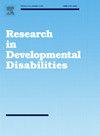非智障自闭症成人的体力活动、久坐时间和心血管疾病风险因素的相关性
IF 2.6
2区 医学
Q1 EDUCATION, SPECIAL
引用次数: 0
摘要
背景越来越多的证据表明,无智力障碍(ID)的自闭症成年人患心血管疾病(CVD)的风险较高。这项横断面调查研究旨在评估心血管疾病的生理和心理健康风险因素的普遍性,并研究体育锻炼(PA)和久坐时间(ST)与无智力障碍的自闭症成年人的心血管疾病风险之间的关系。参与者是通过直接联系美国自闭症倡导组织和社交媒体上的自闭症支持团体招募的。结果较高的 ST 与高血压、中风和心理健康风险因素(抑郁、焦虑、双相情感障碍和强迫症;所有 p < 0.05)的几率增加显著相关。结论 无智障的自闭症成年人过度ST与某些心血管疾病因素的风险增加有关,尤其是那些与不良心理健康有关的因素。作为一种心血管疾病预防策略,健康干预措施应侧重于打破久坐。本文章由计算机程序翻译,如有差异,请以英文原文为准。
Correlates of physical activity, sedentary time, and cardiovascular disease risk factors in autistic adults without intellectual disabilities
Background
Emerging evidence indicates that autistic adults without intellectual disabilities (ID) are at elevated risk of developing cardiovascular disease (CVD).
Aims
This cross-sectional survey study aimed to assess the prevalence of physiological and mental health risk factors for CVD and examine how physical activity (PA) and sedentary time (ST) relate to CVD risk in autistic adults without ID.
Methods
An online self-report survey addressing PA, ST, and CVD risk factors was delivered to 229 autistic adults without ID aged 18–55 years. Participants were recruited via direct contact with autism advocacy organizations in the U.S. and autism support groups on social media. Binary logistic regression analyses were used to explain the impact of PA and ST on CVD risk factors.
Results
Higher ST was significantly associated with increased odds for high blood pressure, stroke, and mental health risk factors (depression, anxiety, bipolar, and obsessive-compulsive disorder; all p < 0.05). No significant associations were found between PA and CVD risk factors.
Conclusions
Excessive ST in autistic adults without ID is associated with an increased risk for certain CVD factors, particularly those related to poor mental health. Health interventions should focus on breaking up prolonged sitting as a CVD prevention strategy in this population.
求助全文
通过发布文献求助,成功后即可免费获取论文全文。
去求助
来源期刊

Research in Developmental Disabilities
Multiple-
CiteScore
5.50
自引率
6.50%
发文量
178
期刊介绍:
Research In Developmental Disabilities is aimed at publishing original research of an interdisciplinary nature that has a direct bearing on the remediation of problems associated with developmental disabilities. Manuscripts will be solicited throughout the world. Articles will be primarily empirical studies, although an occasional position paper or review will be accepted. The aim of the journal will be to publish articles on all aspects of research with the developmentally disabled, with any methodologically sound approach being acceptable.
 求助内容:
求助内容: 应助结果提醒方式:
应助结果提醒方式:


